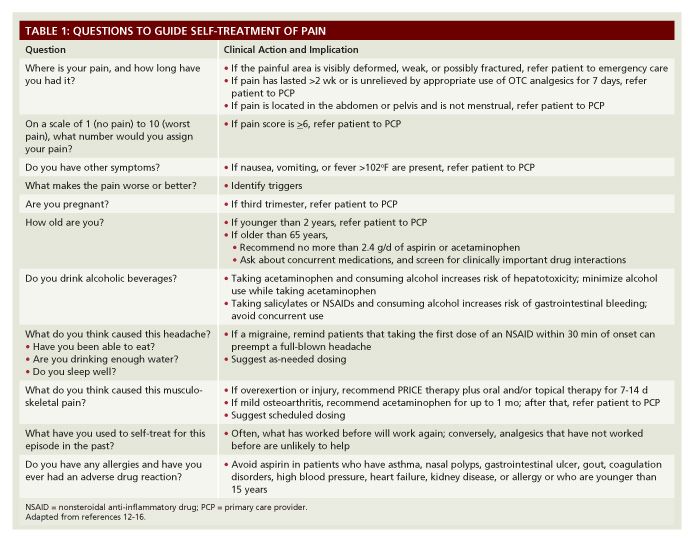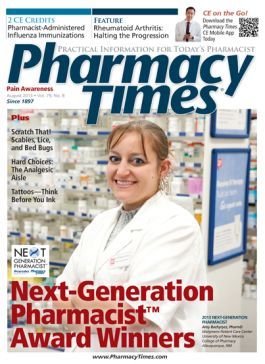Hard Choices: The Analgesic Aisle
Knowledge of each patient's unique needs can help in selecting the most appropriate drug.
Knowledge of each patient’s unique needs can help in selecting the most appropriate drug.
By now, pharmacists should fully understand pain basics: pain starts with nociceptive stimulation and progresses to signal transmission and central decoding, and then the brain registers “ouch!” Every patient’s pain is a unique, unpleasant sensory and emotional experience. The cliché, “I share your pain,” is scientifically implausible for physical pain; no one knows what the patient feels except the patient. Some pain requires multidisciplinary approaches with well-orchestrated interventions. Almost everyone experiences mundane, annoying, easily treatable pain.1 Pharmacists can help patients who are overwhelmed by the OTC analgesic aisle.
Common Pain
Two types of pain are extremely common: headache and musculoskeletal pain. Headache (tension, migraine, and sinus) accounts for about one-half of reported pain and one-third of all OTC analgesic doses.2,3 Musculoskeletal pain is often injury related but can be idiopathic. As patients age, osteoarthritis is a common cause. Women commonly experience menstrual pain. An extensive physical exam, a hard physical therapy session, or a biopsy can cause iatrogenic pain.4-6
OTC Analgesics
When pain creates discomfort, patients can choose from among several oral analgesics (acetaminophen, aspirin, or nonsteroidal anti-inflammatory drugs (naproxen, ketoprofen, and ibuprofen]) as single-entity products or combination products. The plethora of products can confuse patients. Further exacerbating their confusion, one-fourth to one-half of patients do not read product labels.7,8 Perhaps patients believe they know the product or do not realize that from time to time, manufacturers lower the maximum daily dose or change the directions. Some people believe they can dose themselves regardless of label recommendations.7 By ignoring labels, patients may unintentionally exceed the maximum recommended dose or unknowingly purchase a combination product. The more than 380 acetaminophen-containing products are of special concern.7 In recent years, the FDA changed labeling to warn heavy alcohol users about acetaminophen and also decreased the maximum daily dose for 500-mg, OTC, single-ingredient acetaminophen products from 4 g/day to 3 g/day.9-11
Our primary goal is to reduce pain intensity and duration, restore normal function, and avoid side effects. Additionally, avoiding drug interactions is important for patients who take long-term prescription (or nonprescription) medication. Table 1 describes background information needed to make informed choices about OTC analgesia.

Nonpharmacologic Interventions
If headache is the problem, patients may find that relaxation exercises, better hydration, and sleep help. Avoiding triggers can also help. Migraine headache may not respond to OTC analgesics if the headache is fully developed.12 For sinus headache, a decongestant—analgesic combination product may be warranted.
For musculoskeletal conditions, experts recommend PRICE (protection, rest, ice, compression, elevation; online Table 2), although little research supports this intervention.17 Note that ice can relieve soreness, but it reduces muscle strength and power, negatively affecting performance. This means athletes who plan to return to the game immediately should avoid ice.18
Table 2. PRICE for Musculoskeletal Pain
- Protection: Guard the injured area and avoid further injury
- Rest: Rest the injured limb, using splints or crutches if necessary, for a few days
- Ice: Apply ice as soon as possible, then for 10 to 15 minutes three to four times daily
- Compression: Wrap the area with a bandage designed for that body part
- Elevation: Elevate the limb to a level at or above the heart for two to three hours daily
Adapted from references 17-19.
Conclusion
Pharmacists must consider each patient’s unique needs and help patients select the drug, as well as route and mode of administration, that best meets their needs. For some patients (eg, those who have trouble swallowing), a liquid or rectal formulation will be needed. Others may find a counterirritant patch or cream containing menthol or methyl salicylate helpful. Pharmacists should educate patients to take analgesics appropriately, know when they have successfully self-treated, and seek more help if the quality of the pain changes.
Ms. Wick is a visiting professor at the University of Connecticut School of Pharmacy and a freelance clinical writer.
References
- Holdcroft A, Jaggar S, eds. Core Topics in Pain. New York: Cambridge University Press; 2005.
- Smith TR. Epidemiology and impact of headache: an overview. Prim Care. 2004;31:237-241.
- Robbins MS, Lipton RB. The epidemiology of primary headache disorders. Semin Neurol. 2010;30:107-119.
- Sacitharan PK, Snelling SJ, Edwards JR. Aging mechanisms in arthritic disease. Discov Med. 2012;14:345-352.
- Derry S, Moore RA, Rabbie R. Topical NSAIDs for chronic musculoskeletal pain in adults. Cochrane Database Syst Rev. 2012;9:CD007400.
- Quatman C, Yu JS. The aging athlete: part 2: “boomeritis” of the upper extremity. AJR Am J Roentgenol. 2012;199:W307-W321.
- Kaufman DW, Kelly JP, Rohay JM, Malone MK, Weinstein RB, Shiffman S. Prevalence and correlates of exceeding the labeled maximum dose of acetaminophen among adults in a U.S.-based Internet survey. Pharmacoepidemiol Drug Saf. 2012;21:1280-1288.
- The National Council on Patient Information and Education. Uses and attitudes about taking over-the-counter medicines. www.bemedwise.org/survey/summary_survey_findings.pdf. Accessed June 1, 2013.
- FDA. June 29-30, 2009: joint meeting of the Drug Safety and Risk Management Advisory Committee with the Anesthetic and Life Support Drugs Advisory Committee and the Nonprescription Drugs Advisory Committee: meeting announcement, 2009. www.fda.gov/AdvisoryCommittees/Calendar/ucm143083.htm. Accessed May 15, 2013.
- McNeil Consumer Healthcare: supplemental submission to docket FDA-2009-N-0138, September 30, 2009. www.regulations.gov/#!documentDetail;D=FDA-2009-N-0138-0227. Accessed May 15, 2013.
- McNeil Consumer Healthcare. McNeil Consumer Healthcare announces plans for new dosing instructions for Tylenol products, 2011. www.jnj.com/connect/news/all/mcneil-consumer-healthcare-announces-plans-for-new-dosing-instructions-for-tylenol-products. Accessed May 15, 2013.
- MacGregor EA, Brandes J, Gendolla A, Giammarco R. Migraine treatment strategies: the global migraine and zolmitriptan evaluation (MAZE) survey--phase IV. Curr Med Res Opin. 2004;20:1777-1783.
- Hwang U, Platts-Mills TF. Acute pain management in older adults in the emergency department. Clin Geriatr Med. 2013;29:151-164.
- Bárzaga Arencibia Z, Choonara I. Balancing the risks and benefits of the use of over-the-counter pain medications in children. Drug Saf. 2012;35:1119-1125.
- Di Lorenzo L, Goglia C, Pappagallo M. Managing osteoarthritis and joint pain at work: helping the primary care physician educate patients who rely on non-prescription NSAIDs. G Ital Med Lav Ergon. 2011;33:193-200.
- Michels SL, Collins J, Reynolds MW, Abramsky S, Paredes-Diaz A, McCarberg B. Over-the-counter ibuprofen and risk of gastrointestinal bleeding complications: a systematic literature review. Curr Med Res Opin. 2012;28:89-99.
- Reurink G, Goudswaard GJ, Tol JL, et al. Therapeutic interventions for acute hamstring injuries: a systematic review. Br J Sports Med. 2012;46:103-109.
- Bleakley CM, Costello JT, Glasgow PD. Should athletes return to sport after applying ice?: a systematic review of the effect of local cooling on functional performance. Sports Med. 2012;42:69-87.
- Bizzini M. Ice and modern sports physiotherapy: still cool? Br J Sports Med. 2012;46:219.

